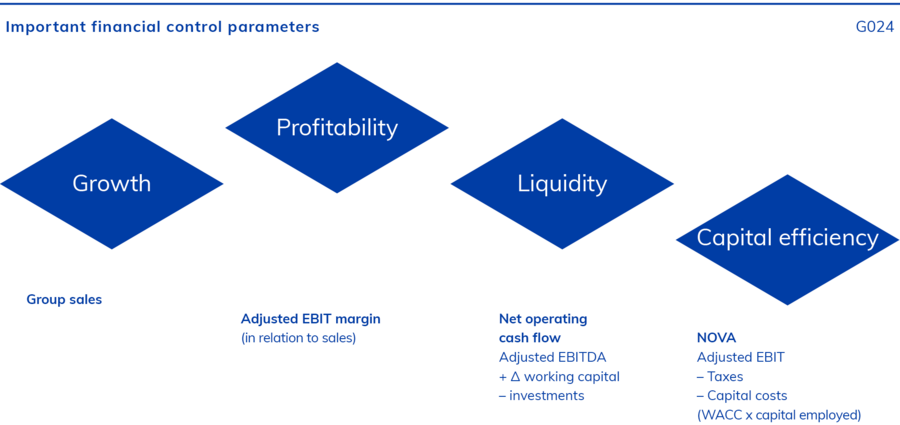Control system and key performance indicators
The consistent focus on the Group objectives mentioned is also reflected in the internal control system at NORMA Group, which relies on both financial and non-financial control parameters.
Important financial control parameters
NORMA Group’s most important financial performance indicators include the following value and growth oriented key figures, which have a direct impact on NORMA Group’s value creation: Group sales, adjusted EBIT margin and net operating cash flow. These key figures lead to the NORMA Value Added (NOVA) as the primary strategic performance indicator. NORMA Group uses these key figures to continuously monitor its success in terms of growth, profitability, liquidity and capital efficiency.

Group sales
As a growth-oriented company, NORMA Group attaches particular importance to profitable sales growth. The Group seeks to achieve short and medium-term growth above the market average. In contrast to previous years and since the fiscal year 2024, the Group is providing an absolute range when it comes to the targeted Group sales figure as part of its forecast. FUTURE DEVELOPMENT OF THE NORMA GROUP
Due to the broad market structure in the area of joining technology, the Management Board is guided by internal analyses as well as studies by leading economic research institutes on the development of the gross domestic product of the respective regions and on the production and sales figures of the relevant customer industries in developing the forecast on the expected development of sales. In addition, management is including selected leading indicators such as customer order behavior in the trading business (Standardized Joining Technology/SJT = strategic business units “Water Management” and “Industry Applications”) and the order backlog in the Engineered Joining Technology segment (EJT = strategic business unit “Mobility & New Energy”) in its forecast.
Adjusted EBIT margin
The adjusted EBIT margin, which shows adjusted EBIT in relation to sales, provides information on the profitability of the business activities and represents a key internal management and evaluation indicator for the Group's ongoing operating activities. In addition, adjusted EBIT forms the basis for the remuneration of the Management Board and the incentive basis for non-tariff employees. In order to maintain the Group’s profitability at a high level,
NORMA Group constantly strives to optimize its company processes and structures. In doing so, the Company focuses primarily on sustainably reducing key cost factors.
For long-term comparison and for a better understanding of how the business is developing, NORMA Group adjusts the operating result for certain expenses in connection with realized M&A transactions. Further information can be found in the section ADJUSTMENTS.
Net operating cash flow
In order to maintain the Group’s financial independence and solvency at all times, NORMA Group is also guided by net operating cash flow in managing the Company. This comprises the most important cash-effective items that can be influenced by the individual business units and provides information on whether NORMA Group can finance its operating business out of its cash flow. It is calculated on the basis of adjusted EBITDA plus changes in working capital, less investments from operations. The main starting points for improving net operating cash flow are therefore to increase sales, to improve the operating result (EBITDA) adjusted for special effects and to engage in sustained value-enhancing investment activity. In addition, consistent management of working capital focusing on continuous optimization also has a positive impact on net operating cash flow.
NORMA Value Added (NOVA)
NORMA Group’s objective is to use the capital provided to it by shareholders and lenders as efficiently as possible in order to ensure the long-term positive development of the Group. In order to manage this, NORMA Group determines the annual increase in value in the form of the so-called NORMA Value Added (NOVA). NOVA is calculated as adjusted EBIT less tax and the cost of capital. The cost of capital is defined by the weighted average cost of capital (WACC) and the capital employed (equity plus net debt).
Legend
These contents are part of the Non-financial Group Report and were subject to a separate limited assurance examination.